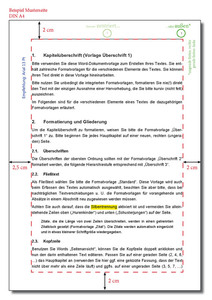
Formatting made easy
We offer you an all-round package for your publication-based release
- Monograph
- Open Access publication
- Cumulative dissertation
- Research volumes
- Conference proceedings
- Scripts
- Textbooks
Our goal is to make your work accessible to the public in a professionally formatted and profitable manner, while ensuring maximum visibility and citation potential.
We’ll show you how it’s done! Take advantage of:
- Our ready-to-use formatting templates, e.g. LaTeX or Word
- Affordable proofreading by our in-house editors and proofreaders
- Our formatting guide (specific information on LaTeX available here)
6 Tips for Formatting
1. General Document Layout
- Odd page numbers always appear on the right, even page numbers on the left
- Main chapters should always begin on the right-hand (odd-numbered) page
- Automatic hyphenation should be enabled
- Avoid: Single lines at the top (“orphans”) or bottom (“widows”) of a page
2. Text Font Size
(excluding footnotes, image captions, etc.)
- A4 document: Minimum 12 pt (important for downscaling to A5)
- A5 document: 9–11 pt – our recommendation: 10 pt
3. Font Style
We recommend serif fonts such as:
- Times New Roman
- Garamond
- Cambria
- Georgia
…or sans-serif fonts such as:
- Arial
- Seoge UI
- Helvetica
- Calibri
4. Font Color
- All fonts (including axis labels etc.) should be 100% black
5. Graphics/Images
- Line width: Minimum 0.5 pt
- Font size in figures: Minimum 10 pt
- For pixel-based graphics (e.g., photos, scans), ensure a resolution of at least 300 dpi
- A graphic should occupy at least 50% of the text width
6. Tables
- Line width: Minimum 0.5 pt
- Axis labels and table content: Font size at least 10 pt
Quality Assurance through Our Layout Templates
Formatting Options and Recommendations for Your Academic Work
With the help of our formatting template, you can easily and quickly design the layout of your publication. We are also happy to take over the formatting of your academic work for you.
For printing your work, we require a digital version in both Word and PDF format. Simply send us your file as an email attachment. For larger files, please use services like WeTransfer or Dropbox.
Please always submit your file in the same format as the intended print size.
Example: For an A5 book, the submitted files should be created in A5; for other formats, please adjust accordingly.
What to Consider When Formatting Your Work Independently
Below is a short guide outlining the key points to keep in mind when formatting your work. (The starting format should always correspond to the format you intend for the final book):
- Margins: At least 2 cm on the right and left for A4 and B5 formats. For A5, margins should be at least 1.8 cm. (See sample page)
- Page Numbers: Centered, or alternating left and right — even-numbered pages on the left, odd-numbered pages on the right
- Font Size: At least 10 pt for A5 and at least 12 pt for A - Header and footer text can be smaller (Recommended sizes: 11–12 pt for A5 and 13–14 pt for A4)
*Other formats, such as intermediate/custom sizes, are also possible. You are welcome to submit your file in your desired final format. If you have any questions or need assistance, we’re here to help at any time.
Our Formatting Templates – The Simple Solution for Your Layout
Take advantage of our free formatting templates for Word and LaTeX.
When submitting your digital file, please include the following information:
Our Formatting Templates for Download
If you decide not to use our print format templates, you will find helpful tips on general formatting in our Guidelines for Preparing LaTeX Files.
Professional Design – Efficient Communication – Comprehensive Support
As soon as your file has been received by our publishing house, we will create a proof print on the same or the next working day. This will be sent to you together with the publishing contract, invoice, proof of the initial print run, and the VG-Wort information sheet – digitally, and by post upon request. We can tailor the initial print run to meet the requirements of your university, if desired.
Once you have reviewed the proof print and cover drafts, and found them to be error-free, you can approve them for printing (via email or post). Any change requests will be implemented promptly to ensure the flawless publication of your academic work.
LaTeX Template for Academic Work?
We provide guidance on LaTeX templates.
Guide for Preparing LaTeX Files
LaTeX is a complex typesetting system that can be individually adapted to your work. However, creating academic papers with LaTeX often leads to inconsistencies in the printed image due to formatting issues.
As a publisher committed to the highest quality standards, we have created a basic LaTeX template to minimize errors. Using this template allows us to more easily identify the source of any printing issues. If you choose to further develop the template or not use it, please consider the following points to ensure optimal print quality:
General Formatting Guidelines:
- Odd-numbered pages must always appear on the right, even-numbered on the left.
- Main chapters must always begin on a right-hand page.
- Ensure that hyphenation is activated and avoid single lines at the top (“widows”) or bottom (“orphans”) of pages.
- The front matter should always consist of 4 pages: half-title, blank page, main title, and imprint. The imprint page only needs to be set up – we will finalize its content.
- Generate the table of contents automatically based on styles.
- To meet academic standards, please provide your ORCID and ISNI numbers.
- If you would like a DOI, please indicate this on the order form.
Font Size:
- For A4 documents, set the text font size to at least 12 pt (excluding footnotes, captions, etc.). For A5, we recommend 10 pt.
➢ This is important to avoid text becoming too small when scaling to A5 (scaling factor from A4 to A5 is approx. 70%).
- For A5 documents, use a text font size of 8–11 pt (excluding footnotes, captions, etc.).
- In LaTeX, explicitly check whether the editor supports the selected font size – otherwise, a warning or error will occur during compilation. If unsupported, use the next larger or smaller size.
Schriftart:
- Bitmap fonts can cause printing issues; we recommend avoiding them.
- Recommended standard fonts include:
➢ Arial
➢ Times New Roman
- Aus Erfahrung raten wir von einigen Schriften mit Serifen (z.B. „CMR“ und „LMRoman“) ab, da diese im Druck zu Unsauberkeiten führen.
- Based on experience, we advise against serif fonts like CMR or LMRoman, as they may print unclearly.
If you prefer a serif font, consider Nimbus Roman in a larger size (14–15 pt for A4, 12–13 pt for A5) to ensure clarity in print.
4. Font Color:
- Ensure that all fonts (including axis labels, etc.) are set to 100% black.
➢ Other colors are possible, but often result in poor print quality. Especially gray tones tend to appear fuzzy in print. Strong, saturated colors are preferable.
5. Graphics/Images:
- Lines must be at least 0.5 pt wide.
- Font size in images: at least 10 pt.
- For pixel-based images (e.g. photos, scans), ensure a minimum resolution of 300 dpi.
- Graphics should occupy at least 50% of the text width.
- Due to the upcoming Accessibility Act, authors and publishers will be required to provide alternative text for all images here.
- Supported image formats in LaTeX: PS, EPS, PDF, GIF, JPG, PNG, TIF.
- We recommend printing your graphics in various colors beforehand to assess how well they will appear in print.
- Issue: When inserting a graphic into a LaTeX document, LaTeX converts it into PDF. When the entire document is compiled into PDF again, this results in a PDF-inside-a-PDF situation, which can degrade quality.
➔ To ensure optimal print quality, please also send us the graphics separately as bitmap files (e.g. PNG or JPG).
6. Tables
- Lines must be at least 0.5 pt wide.
- Axis labels and table content: font size minimum 10 pt.
7. Additional Notes:
- Do not ignore warnings during compilation regarding font type, font size, or graphics.
➢ These may indicate that some packages (e.g. math environments) are not compatible with each other.
- To avoid problems when converting your A4 PDF into A5, we recommend compiling your LaTeX file directly in A5 format.
➢ Add the parametera5paperto your LaTeX document class. Keep in mind that the font size must also be adjusted accordingly.
After you give final print approval, your books will be shipped to you within 3–8 business days.
If you have further questions or need support, we are happy to assist you by phone, email, or in person at our publishing house – with all our expertise and commitment.








